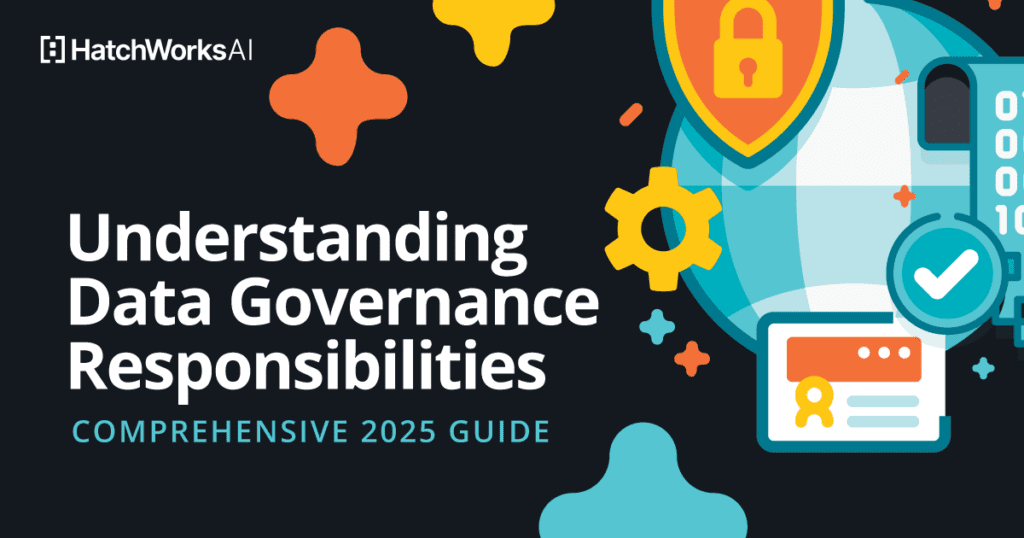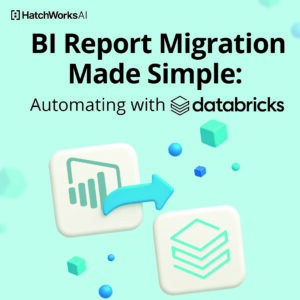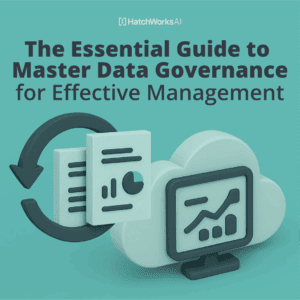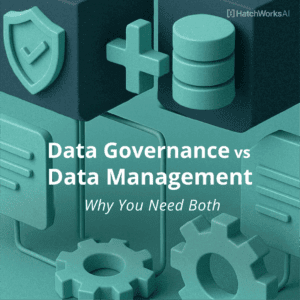Organized data is one of the most valuable assets an organization can have. AI needs it to deliver accurate insights and innovative solutions.
But it only works well if the data is clean. To make that a reality, you need to set up data governance responsibilities in your organization.

This article explores the key roles involved in governance, actionable initiatives for implementation, and practical tips to align governance with business goals.
By the end, you’ll have a clear roadmap to strengthen your governance efforts.
What is Data Governance?
Data governance is a system of policies, roles, and tools that keeps your data accurate, secure, and easy to use.
Ultimately, it turns your data into an asset and a differentiator. With it you have the tools to fuel decisions and meet compliance requirements.
Many organizations use platforms like Databricks to implement scalable governance frameworks that support collaboration and innovation without compromising security.
At HatchWorks AI, we partner with Databricks to help our clients leverage their data in their use of AI.
Why Data Governance Responsibilities Matter in 2025
Falling behind on compliance with GDPR, CCPA, or HIPAA can lead to hefty fines, legal challenges, and reputational damage.
But effective governance also plays a pivotal role in business success.
Accurate, well-governed data enables faster decision-making, drives innovation, and supports impactful AI initiatives. Businesses that fail to protect and optimize their data risk falling behind competitors who treat governance as a priority and data as an asset.
💡 To learn more about the foundational pillars that support robust governance, check out Practical Data Governance Pillars: Safeguarding Your Digital Assets.
Key Roles and Responsibilities in Data Governance
Let’s explore the key data governance roles of an entire data governance program and their responsibilities:
- Chief Data Officer
- Data governance manager
- Data owners
- Data stewards
- Data custodians
- Data users
- Data Governance Councils
Chief Data Officer (CDO)
The CDO leads the overall data governance strategy, ensuring it aligns with business objectives.
Responsibilities include setting governance policies, championing data-driven initiatives, and overseeing compliance with regulatory standards. The CDO also drives collaboration across teams and communicates the value of data governance to leadership.
Who typically takes this role? Senior executives with expertise in data strategy and business operations.
Data Governance Manager
This role focuses on operationalizing governance policies and tracking the success of governance initiatives.
They ensure policies are implemented effectively, coordinate across departments, and monitor compliance metrics like data quality and security.
Who typically takes this role? Mid-level managers or senior data professionals with project management experience.
Data Owners
Data owners are accountable for specific datasets, ensuring their accuracy, security, and alignment with business objectives.
Responsibilities include controlling access, overseeing data quality, and setting rules for usage.
Who typically takes this role? Department heads or senior managers in areas like IT, finance, or marketing, depending on the data domain.
Data Stewards
Data stewards focus on operational tasks, such as maintaining accuracy, resolving issues, and ensuring compliance.
They manage metadata and collaborate with data owners to implement governance processes effectively.
Who typically takes this role? Analysts, data managers, or operational staff in IT or specific business units.
Data Custodians
Custodians manage the technical aspects of data governance, including storage, security, and infrastructure.
They ensure data is accessible to authorized users and protected from unauthorized access or breaches.
Who typically takes this role? IT professionals responsible for database administration or system architecture.
Data Users
Data users are the employees who rely on data for their roles.
They are responsible for using data ethically and adhering to governance policies. They also provide feedback on accessibility and usability to improve governance processes.
Who typically takes this role? Employees across all departments who interact with organizational data.
Data Governance Council
Governance councils provide strategic oversight, create data governance policies, and ensure accountability.
They align governance initiatives with organizational goals and address cross-functional challenges.
Who typically takes this role? Senior executives, legal/compliance officers, and representatives from IT, operations, and business teams.
👉 To learn more about bridging business goals with clear data roles, check out The Essential Role of a Data Product Manager: Bridging Business Goals and Responsible Data Strategy.
Core Responsibilities in Data Governance
Effective data governance revolves around a few core responsibilities that ensure data remains a reliable, secure, and accessible resource for the organization.
These responsibilities provide the foundation for achieving business goals while mitigating risks, and they often span roles.
For example, let’s look at how the roles above intersect:
- Chief Data Officers (CDOs) and Data Governance Managers both oversee governance initiatives, but the CDO focuses on strategy and alignment with business goals, while the manager handles implementation and tracking.
- Data Owners and Data Stewards both ensure data quality, but owners are accountable for high-level oversight, while stewards handle operational tasks like resolving discrepancies.
- Data Custodians and Data Stewards share responsibility for maintaining data accuracy and security, but custodians focus on technical infrastructure, while stewards ensure compliance and usability.
These overlaps highlight the need for collaboration while ensuring no responsibilities fall through the cracks.
Ensuring Data Quality
This involves setting standards for accuracy, completeness, and consistency to ensure reliable data for decision-making. Metrics like duplicate-free records, validated entries, and timely updates help monitor quality. Implementing these standards prevents issues like flawed reporting or operational inefficiencies.Managing Data Security and Privacy
Data governance also protects sensitive information by enforcing security protocols and adhering to regulations like GDPR and HIPAA. Policies around encryption, role-based access, and regular audits minimize the risk of breaches and non-compliance.
These measures build trust with customers and safeguard data assets.
Facilitating Data Access
Striking the right balance between accessibility and security is key. Governance frameworks enable authorized users to access data when needed while protecting it from unauthorized use.
Strategies like role-based permissions and tiered access controls ensure that the right people have access without compromising security.
Implementing Data Governance Initiatives
Strong data governance doesn’t happen by accident—it requires clear policies, the right tools, and a strategic approach.
Here’s how organizations can translate governance strategies into actionable initiatives:
Establishing Clear Governance Policies
Strong governance starts with clear, actionable policies. These policies should define how data is used, stored, and shared, providing the guardrails for consistent and compliant data management. Leveraging established frameworks like DAMA-DMBOK or ISO 27001 helps ensure policies are thorough and practical, setting the foundation for effective governance across teams.
Leveraging Technology for Data Governance
Technology is the enabler of scalable governance. Tools like data catalogs and lineage tracking systems provide visibility and control over data, ensuring it’s accurate and accessible. Platforms such as Databricks’ Unity Catalog or Collibra offer comprehensive solutions for managing compliance, monitoring data quality, and automating governance workflows.
🔍 For insights on advanced data management strategies and self-serve analytics, check out Unlock Self-Serve Analytics with Data Governance MDM: Our How-To Guide.
Common Challenges in Data Governance
When we help organizations implement data governance, there are two key challenges we see come up time and time again.
Lack of Organizational Buy-In
Without buy-in from decision makers, teams often lack the resources and authority needed to enforce policies effectively.
To secure buy-in, demonstrate how governance aligns with strategic goals, such as compliance, risk mitigation, and competitive advantage.
Highlighting ROI—like reduced errors or faster decision-making—can also make a compelling case for leadership support.
But leadership isn’t the only part of your organization you need on side. You also need to win over day-to-day users of data.
The key to getting people on board is education and communication. Make sure everyone understands why these rules exist and how they benefit the organization. Simplify policies where possible and provide training to make compliance easier. Incentivize adherence by tying governance success to measurable outcomes, like improved workflows or fewer errors.
Overcoming Silos
Disconnected teams create bottlenecks in governance efforts by duplicating work, using inconsistent processes, or failing to share data.
Collaboration practices such as cross-functional governance committees or shared data platforms help bridge these gaps. Encouraging transparency and communication ensures all departments work toward the same governance objectives, breaking down silos that hinder progress.
How to Align Data Governance Responsibilities with Business Goals
Articulating ROI from Data Governance
To align governance with business goals, articulate its tangible benefits. For instance, reducing duplicate records can cut storage costs, while improved data quality leads to faster, more accurate decision-making.
Highlight real-world examples, like companies saving millions by avoiding compliance fines or generating revenue through better-targeted marketing campaigns. These success stories showcase how governance drives measurable business outcomes.
Integrating Governance into Existing Workflows
Governance shouldn’t feel like a separate task. Instead, it should seamlessly integrate into existing processes.
Embed responsibilities into agile workflows, where small, iterative improvements can ensure governance doesn’t disrupt productivity.
For example, you can incorporate data quality checks into sprint reviews or use automation tools to monitor compliance and make governance a natural part of daily operations.
How to Measure the Success of Data Governance Initiatives
Don’t let data governance become another initiative that is implemented and never measured.
You’ll want to start by defining key performance indicators (KPIs) that align with your business objectives and compliance needs.
For example, if your goal is to improve customer retention, track data accuracy in CRM systems to ensure customer records are complete and up to date. If compliance is a priority, measure adherence to data privacy regulations like GDPR or HIPAA.
Here are a few metrics you can track to get started:
- Data quality improvements, such as reduced duplicate records or increased completeness and accuracy.
- Compliance rates, ensuring adherence to regulations like GDPR or HIPAA.
- Stakeholder satisfaction, gauged through feedback on data usability and access.
To make tracking easier, leverage data catalogs and quality monitoring tools that provide real-time insights into data accuracy and compliance. Platforms like Databricks’ Unity Catalog can centralize governance efforts, making it easier to measure and maintain success.
These metrics and tools ensure governance initiatives deliver measurable business value.
Resources for Further Learning
Explore these HatchWorks AI resources to deepen your understanding of data governance:- Why We Use Databricks for Data Governance: Discover how HatchWorks leverages Databricks to deliver scalable, efficient, and compliant governance solutions for our clients.
- Practical Data Governance Pillars: Safeguarding Your Digital Assets: Understand the essential pillars that support robust data governance frameworks.
- The Essential Role of a Data Product Manager: Bridging Business Goals and Responsible Data Strategy: Explore how aligning data roles with business objectives drives strategic success.
- Unlock Self-Serve Analytics with Data Governance MDM: Our How-To Guide: Discover how to streamline your data governance and master data management processes using advanced tools and AI-driven solutions.
Ready to Strengthen Your Data Governance?
Take the first step by assessing your organization’s current governance strategy. Are your goals aligned with business objectives? Are you leveraging the right tools and frameworks to maximize impact?
HatchWorks AI is here to help. Learn more about our AI development offerings and take our AI Data Readiness Governance Assessment.
Spots are limited so grab yours now.
Make Data Your Biggest Differentiator
We build scalable, modern data systems tailored for AI.
Using Databricks’ industry-leading platform, we ensure your data is ready, secure, and optimized for AI.



